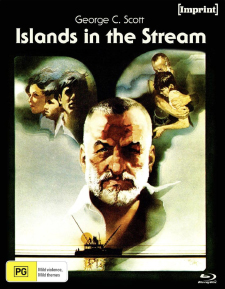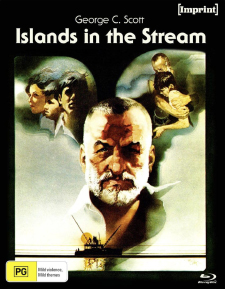Islands in the Stream (Blu-ray Review)

Director
Franklin J. SchaffnerRelease Date(s)
1977 (January 5, 2024)Studio(s)
Paramount Pictures (Imprint/Via Vision)- Film/Program Grade: A-
- Video Grade: A
- Audio Grade: A-
- Extras Grade: B+
Review
Loosely adapted from Ernest Hemingway’s posthumously-published novel, Islands in the Stream (1977) is not particularly remembered today, though it’s easy enough to see why. Neatly divided into three distinct acts, the first two parts are superb in just about every way, while the final act is curiously lacking the care and precision of all that came before. Still, overall, it’s a much better film than its reputation suggests and one of the best Hemingway film adaptations.
This is surprising since the film deviates from the novel’s story in myriad ways, while retaining its basic structure and tone. For instance, in the novel the last third involves Hudson (played by George C. Scott in the film) obsessively tracking down the German survivors of a sunken U-boat after they massacred the residents of Cuban village, Hemingway heavily influenced by his earlier success For Whom the Bells Toll. Conversely, the film jettisons all that in favor of what amounts to a rehash of To Have and Have Not. Hemingway’s novel was mostly written during 1950-51, but abandoned and not published until 1970, nine years after his death.
Like the novel, the film takes place on an island in The Bahamas in 1940, after the start of World War II and the Fall of France but prior to the U.S.’s entry into the war. A brief prologue establishes that twice-divorced artist Thomas Hudson (Scott) has given up painting for sculpture (cutting and welding pieces of metal into abstract forms) and lives alone, though looked after by Joseph (Julius Harris) and frequently visited by alcoholic friend Eddy (David Hemmings), seemingly a distant cousin of Walter Brennan’s character in To Have and Have Not.
In The Boys, Hudson is reunited with his three children, 17-year-old Tom (Hart Bochner) from his first marriage, and the much younger Andrew (Brad Savage) and David (Michael-James Wixted) from his second. Both he and they are at first very uncomfortable around one another. Hudson sees their arrival as a disruption of his routine, while the younger boys remember Hudson beating their mother, the middle son particularly fearful and resentful. The dynamic of Hudson’s relationship with his boys changes dramatically during a fishing trek when the middle son hooks an enormous Marlin and struggles for more than three hours to reel it in.
In The Woman, Hudson’s first wife, Audrey (Claire Blooms), the one true love of his life, arrives on the island unexpectedly. In the last and weakest act, The Journey, Hudson decides to help Jewish refugees being smuggled into Cuba by Captain Ralph (ageless Gilbert Roland) when his boat is sunk by a U-boat, Hudson determined to complete Ralph’s mission.
Director Franklin J. Schaffner for a time wanted Steve McQueen to play Hudson, but watching the film, one can’t imagine a better fit for the part than George C. Scott. Hemingway’s novel had autobiographical elements to begin with, Scott resembled Hemingway in his later years, and like Hudson/Hemingway, Scott was a heavy-drinker prone to violence, at times misanthropic, and a talented but rather self-loathing artist. He could walk through or be unpardonably hammy in film roles he held in contempt, but Scott clearly identified with Hudson and seems to have believed in this project, giving one of his very best performances.
I’d seen Islands in the Stream once before, decades ago, and it made almost no impression at all. This time, I was taken aback by its raw emotional power in a number of scenes, and by its unusual precision in all departments—the acting and direction, the cinematography (by Fred J. Koenekamp) and musical score (by Jerry Goldsmith, who considered this his finest work), at least for its first two-thirds.
The fishing sequence overcomes its superficial resemblance to a similar one in Jaws, still fresh in everyone’s minds in 1977, and over the course of its 20 or so minutes, is far superior to anything in the clunky film of Hemingway’s The Old Man and the Sea. The middle son, old enough to remember seeing Hudson beat his mother, is determine to reel in the Marlin unaided. He becomes exhausted, his hands and feet bloody as the hours of struggling add up. Everyone else aboard becomes deeply concerned for the boy, no one more than Hudson, who delicately tries to help the boy without ever overruling his determination to land the fish without help. How that battle between boy and fish ends is less important than how it transforms the relationship between a father and son. It’s a remarkable sequence.
The much shorter The Woman, builds upon information and backstory revealed slowly in the previous act. Hudson has never really loved any woman except for that first wife, Audrey, and when she suddenly turns up, he’s hopeful their broken relationship might possibly be restored, even though the purpose of her visit seems to be to tell him she’s planning on remarrying. The revelation of what’s really behind the visit is superbly written (by Denne Bart Petitclerc, a longtime friend of Hemingway’s), directed and acted.
In The Journey, the film doesn’t really fall apart, but it’s incongruously clumsy and unsatisfying. For instance, during The Boys, Hudson and others observe a freighter burning on the horizon just after dark, a victim of a Nazi U-boat, and later find the body of a young sailor washed ashore, rigor mortis locking the corpse into a frightful position as if he were hanging onto a rope. These scenes are beautiful, hauntingly staged, yet all of the action in The Journey looks sloppy and rushed. Crucial shots that might have clarified spatial relationships better are missing, bits of action begin suddenly without establishing shots, etc., and the final moments of the picture, intercutting what are supposed to be abstract quasi-hallucinations, doesn’t play at all, with none of the intended impact it clearly desires.
Imprint’s Region-Free Islands in the Stream, apparently the only Blu-ray version currently available anywhere in the world, looks outstanding. Koenekamp’s use of 2.35:1 Panavision is superb, and the Blu-ray is razor-sharp with accurate color and contrast. Made on the cusp of the Dolby Stereo revolution, the LPCM 2.0 mono is very good for what it is, though one longs to hear Goldsmith’s excellent score in full stereo. Optional English subtitles are provided.
Extras consist of a new audio commentary by Samm Deighan and two featurettes: Survival Scars: Franklin J. Schaffner as Auteur, hosted by Daniel Kremer; and For Whom the Camera Shoots, with Kremer and Nat Segaloff discussing the many film adaptations of Hemingway stories.
That Islands in the Stream fizzles so unceremoniously toward the end doesn’t diminish its considerable achievements during its first 70 or so minutes, which remain among the best Hemingway material yet brought the screen. Highly Recommended.
- Stuart Galbraith IV

